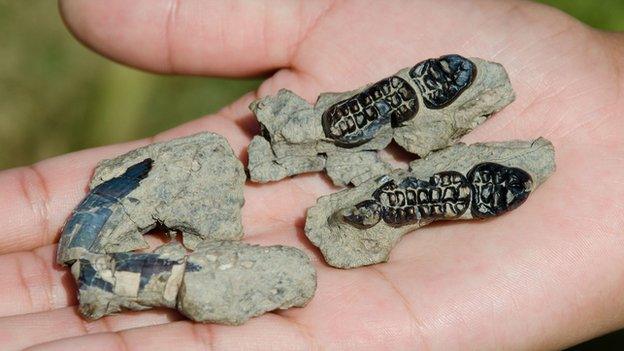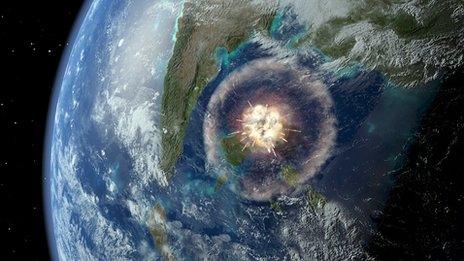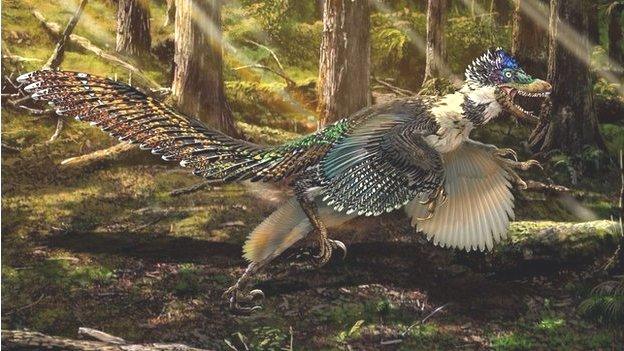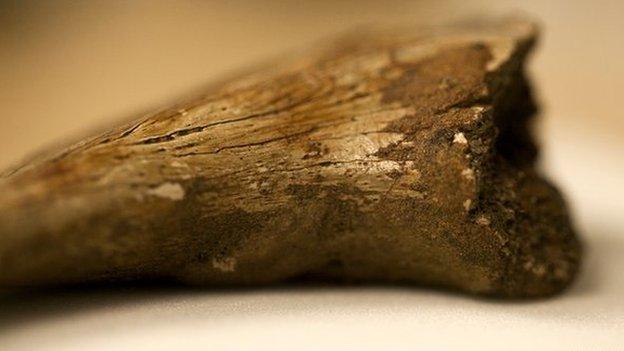Newly discovered mammal species survived dinosaur extinction
- Published
The University of Edinburgh's Dr Stephen Brusatte explains how mammals thrived after the dinosaurs became extinct
Scientists have discovered a species of ancient mammal that survived the event that led to the extinction of the dinosaurs.
The remains of this large, rodent-like creature give clues about how mammals "took over" when dinosaurs died out.
Kimbetopsalis simmonsae, as the newly discovered species has been named, was a plant-eating creature that resembled a beaver.
The news is published in the Zoological Journal of the Linnean Society., external
Dr Stephen Brusatte from the University of Edinburgh, lead researcher on the study, explained how a student on his team called Carissa Raymond found the fossil while prospecting at a site in New Mexico, US.
"We realised pretty quickly that this was a totally new type of mammal that no-one has seen before," he told BBC News.
The researchers noticed in particular the animal's teeth, which were specialised for plant-chewing, with complicated rows of cusps at the back and incisors at the front for gnawing.
They named the species after Kimbeto Wash, the area in the New Mexico badlands where it was found.
"The other part of the name - psalis - means 'cutting shears' and is in reference to [the] blade-like teeth," Dr Brusatte explained.
After the asteroid
This group of now-extinct mammals, collectively known as multituberculates, originated alongside the dinosaurs, during the Jurassic and thrived for more than 100 million years until they were apparently superseded by rodents.

The complex plant-eating teeth of Kimbetopsalis simmonsae were almost perfectly preserved (c) Steve Brusatte/University of Edinburgh
"[During the Jurassic] these animals were all pretty small," said Dr Brusatte.
"Then the asteroid hit, wiped out the dinosaurs and suddenly - in geological terms - this [group of animals] started to proliferate and get bigger.
"That's how the rise of mammals started and really the end result of that is us being here today."
The scientists say that this, and other mammal discoveries from that "brave new world", paint a picture of how mammals made it through the extinction event.

A cosmic disaster?

66 million years ago, an asteroid almost six miles across crashed into the Earth.
The impact was the equivalent of over a billion Hiroshima bombs, and blasted dust into the atmosphere - shrouding the planet in darkness.
Over half of all life on Earth was wiped out. Without this, small shrew-like mammals, the ancestors of all humans, may never have flourished.

"A whole lot of mammals did die, but this group is one that made it through pretty well," Dr Brusatte explained.
"Literally, the world changed one day.
"That asteroid hit and suddenly the dinosaurs are wiped out. It looks like mammals were just waiting their turn and as soon as the dinosaurs disappeared, they thrived."
- Published16 July 2015

- Published9 June 2015
